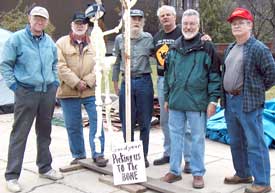Strikers to Goodyear: Stop ‘picking us to the bone’
By
Martha Grevatt
Akron, Ohio
Published Oct 22, 2006 10:48 PM
Ghosts, witches and skeletons,
even tombstones—these are a common sight this time of year. Outside the
last existing Goodyear plant in Akron, however, their purpose is not to greet
the hungry trick-or-treaters. On strike since Oct. 5, members of United Steel
Workers of America (USWA) Local 2L have put up a skeleton with a sign accusing
Goodyear of “picking us to the
bone.”
|
Their numbers are down, but the spirit of
Goodyear workers is up.
WW photo: Martha Grevatt
|
At another entrance the
pickets have erected tombstones with names of cities—Akron, Buffalo,
Gadsden, Lincoln, Union City—that have been dying as plants manufacturing
rubber and other goods are
closed.
Altogether about 15,000 USWA
members are striking at 16 plants in the U.S. and Canada. Key issues include
Goodyear’s plans to close two entire plants and eliminate 5,000 jobs,
threats to the pensions of current and future retirees, and a five-tier pay
scale that would employ new hires for 40 percent less than that paid current
employees, who may also face a pay cut.
At one time the rubber industry dominated the Akron landscape, employing over
50,000 workers—12,000 at Goodyear alone. Like the steel and auto unions,
the United Rubber Workers waged fierce battles to win recognition from the likes
of Goodyear, Firestone and B.F. Goodrich. These battles, which made Akron a
union town, became part of the rich labor history of Northeast
Ohio.
It is a history that is not
forgotten. When asked if there was 100 percent support in the community, a
striker replied, with total seriousness, “Well, I think it’s more
like 99.9 percent. There is one guy who keeps driving by and telling us to get a
job.”
International solidarity is
already a factor also. Fred Higgs, secretary general of the International
Federation of Chemical, Energy, Mine and General Workers Unions (based in
Brussels) called on “trade unions in the rubber industry—and
particularly Goodyear plants in Central and South America—to monitor
inventories and production to ensure that they are not undermining the
USWA’s strike action.”
The
fight for job security is indeed
critical.
Now the rubber industry is
almost all gone—it truly is running with a skeleton crew. The rubber
workers union was so reduced in number, it chose to merge with the Steelworkers.
The only Goodyear tire plant left here employs less than 500 people, who make
specialized tires for NASCAR stock car races. Future NASCAR races, which are
enormously popular in the U.S., could be jeopardized if the strike goes
on.
“I’ve been saving for
this day since 1976,” one striker told this reporter, referring to the
146-day strike that won a cost of living adjustment. “He [the Goodyear
CEO] has to borrow a billion dollars.” Days earlier Goodyear took out
loans for almost that amount, specifically to weather the effects of the
strike.
Their numbers may be diminished,
but the spirit of Goodyear workers is as strong as it was 30 years ago.
Articles copyright 1995-2012 Workers World.
Verbatim copying and distribution of this entire article is permitted in any medium without royalty provided this notice is preserved.
Workers World, 55 W. 17 St., NY, NY 10011
Email:
[email protected]
Subscribe
[email protected]
Support independent news
DONATE


